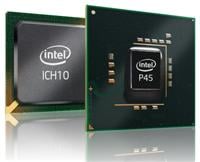MSI P45 Platinum and Diamond Motherboards
MSI P45 Diamond Layout

![]()
MSI P45 Diamond
A girl's (or guys) best friend
Next we get to the top of the food chain in MSI's P45 offerings: the P45 Diamond. Although similar in some aspects to the P45 Platinum, there are some major differences in the layout of the components, especially regarding the cooling.
Power connectors are in the same locations, but other components have been moved about such as the SATA and IDE ports swapping positions. One of the PCI-E X1 slots also moves to the inside of the main PCI-E graphics slots, with the two PCI slots still on the other side. This slot should be used for the riser card with the X-Fi's output jacks, although this is not mandatory and any PCI-Express slot could be used instead. As with the Platinum, there are six fan headers once again, with one moved towards the edge of the board. Coloring has also been changed a bit, with blue and pink DDR3-keyed DIMM slots and maroon SATA ports supplied by the nearby JMicron JMB363 chip. The JMicron JMB363 controller supports the IDE port and two SATA devices, while the JMB362 controls the two external eSATA ports. Three buttons are located near the front corner, with larger writing on the PCB to identify them as power and reset buttons. The third button is shown in the manual, but its use is not covered. LEDs are placed everywhere, lighting up the board when powered and can be used to diagnose problems with the setup, although the manual still must be referred to decipher the problem. The PCI-E slots that will be used for graphics cards are once again colored in shades of blue, with the spacing between the two optimal for multi-card use. Rear I/O options, however, get a facelift, sporting two PS/2 ports, 8 USB 2.0 ports, 2 LAN jacks, 2 eSATA ports, a single IEEE-1394 port, and the ever-useful Clear CMOS button. With the additional JMicron chip, MSI has offered an additional eSATA port over the Platinum version. Also, with the use of the X-Fi riser card for onboard audio output, MSI was able to tack on two additional USB ports and another LAN jack. And who doesn't want extras like that?






















